Blowing the Doors Off the Barn: Expanding the Iron Fist Mythos
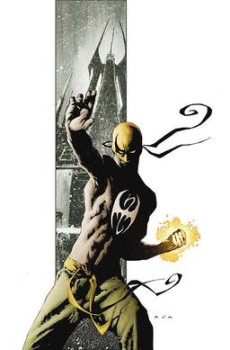 Marvel’s Iron Fist has not traditionally been one of those characters that attracted me. I first encountered him in a second-hand Power-Man and Iron Fist I got in my first year of collecting comics in 1981.
Marvel’s Iron Fist has not traditionally been one of those characters that attracted me. I first encountered him in a second-hand Power-Man and Iron Fist I got in my first year of collecting comics in 1981.
I didn’t get the odd-couple humor, nor the 1970s movie aesthetic that drove the creation of these heroes. Maybe I just wasn’t ready to dig a character who wore slippers. In my defense, I didn’t cotton to Karnak of the Inhumans either. So maybe it’s was the karate chops.
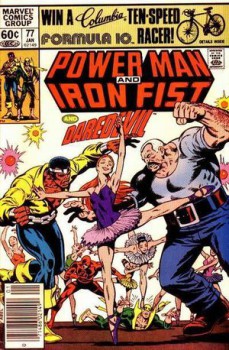 As a teen, I was briefly and underwhelmingly exposed to the black and white magazine-sized martial arts books Marvel published in the 1970s. The only positive sound I ever made when Iron Fist showed up on my radar was when he was drawn by John Byrne and when he briefly crossed paths with the X-Men.
As a teen, I was briefly and underwhelmingly exposed to the black and white magazine-sized martial arts books Marvel published in the 1970s. The only positive sound I ever made when Iron Fist showed up on my radar was when he was drawn by John Byrne and when he briefly crossed paths with the X-Men.
That all changed for me in a 2006-2009 run of The Immortal Iron Fist written by Ed Brubaker, Matt Fraction, and Duane Swierczynski, and pencilled by Travis Foreman and David Aja. Why?
Before 2006, a few things were clear about Danny Rand, the Iron Fist. He was trained in the mystical city of K’un L’un after the deaths of his parents. He is one of a long line of successive possessors of the Chi force that he got from the Dragon of K’un L’un. His arch-enemy is the Steel Serpent, a bit of a bad apple from K’un L’un. It’s a tight superhero set-up, and to my taste, a bit tepid.
But in “The Last Iron Fist Story” (issues #1-6 of the Immortal Iron Fist), Brubaker and Fraction reveal that Danny is not the only living Iron Fist. His predecessor is still alive and kicking (sorry…); he’s been hiding in an opium haze for decades.
When the enemies of K’un L’un find him, he has to leave opium, in anticipation of something called the Tournament of the Seven Capital Cities.
[Click on any of the images for bigger versions.]
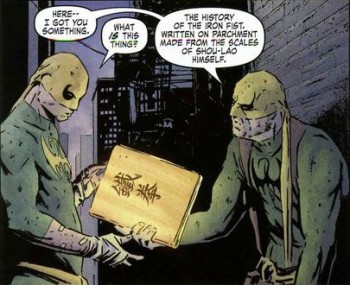 There’s a lot of action and suspense and mystery and Hydra, but this older Iron Fist cracks open a world that Danny didn’t know about and is far, far more interesting than anything that has come before in the Iron Fist stories. And in flashback, we don’t just see this fallen Iron Fist, but 1-2 page vignettes of Iron Fists through the ages; their role and nature is hugely expanded.
There’s a lot of action and suspense and mystery and Hydra, but this older Iron Fist cracks open a world that Danny didn’t know about and is far, far more interesting than anything that has come before in the Iron Fist stories. And in flashback, we don’t just see this fallen Iron Fist, but 1-2 page vignettes of Iron Fists through the ages; their role and nature is hugely expanded.
But this is just the appetizer.
In “The Seven Capital Cities of Heaven” (issues #8-14 of The Immortal Iron Fist), Danny is summoned back to K’un L’un to fight the champions of the other six celestial cities.
Yeah, you heard me. There isn’t just K’un L’un. There are six other mystical cities phasing in and out of contact with the world, each with their own magical martial arts champion. Not only that, but there is a mysterious eighth city hidden somewhere. The originality of the other champions, the action of the tournament and the political and military machinations propel this story forward, multiplying the size of the Iron Fist mythos by seven.
You’d think that after this big an expansion that there could be no more secrets or surprises for readers of Danny Rand, but “The Mortal Iron Fist” (#16-20 of The Immortal Iron Fist) Danny discovers on his 33rd birthday that no Iron Fist has ever lived beyond their 33rd birthday (with the exception of Danny’s immediate predecessor who hid by drugging himself stupid). The killer of all those Iron Fists is associated with the mysterious eighth celestial city and the end of this arc leaves Danny with a map of how to get there.
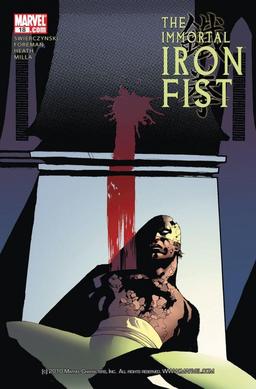 The last growth in this pretty incredible run was “Escape from the Eighth City” (#22-23, #25-26 of The Immortal Iron Fist). All seven immortal weapons (Iron Fist and the other six) travel to the eighth celestial city, to discover that it is in fact a prison in which centuries of corrupt rulers of the celestial cities have dumped political dissidents. The adventure is the survival and prison break story that fills out the depth and history of the Iron Fist world, all the way back to the first Iron Fist.
The last growth in this pretty incredible run was “Escape from the Eighth City” (#22-23, #25-26 of The Immortal Iron Fist). All seven immortal weapons (Iron Fist and the other six) travel to the eighth celestial city, to discover that it is in fact a prison in which centuries of corrupt rulers of the celestial cities have dumped political dissidents. The adventure is the survival and prison break story that fills out the depth and history of the Iron Fist world, all the way back to the first Iron Fist.
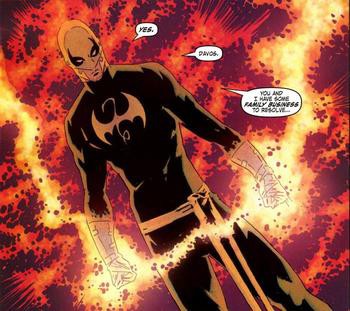 The dramatic expansion of a mythos is a long tradition in comics. Superman encountering the lost city of Kandor is one example.
The dramatic expansion of a mythos is a long tradition in comics. Superman encountering the lost city of Kandor is one example.
Green Lantern first being summoned to Oa to meet the Guardians and the other 3,599 Green Lanterns was a similar moment, as was the introduction of Sinestro, and later the Sinestro Corps.
The best other example of expanding a mythos to my mind is Geoff Johns’ Blackest Night (2009-2010), when we find that the entire Green Lantern Corps and the Sinestro Corps are only two of seven colors of power rings and that the seven together are the subject of a prophecy of cosmic proportions that plays out in Blackest Night and Brightest Day.
I think that there’s something very powerful in storytelling when the hero (and reader) step onto a rise and find a wider world that recontextualizes everything that came before. If you want that feeling, I recommend checking out The Immortal Iron Fist run. It comes in four trade paperbacks, but if digital is your thing, I’m sure Comixology has it.
Derek Künsken writes science fiction, fantasy and struggles with horror in Gatineau, Québec. He tweets from @derekkunsken. Now that he thinks about it, Derek read The Immortal Iron Fist run not long before writing his hard sf martial arts novelette “Way of the Needle” which won the Asimov Award and can be listened to for free courtesy of the nice folks at Escapepod.org.
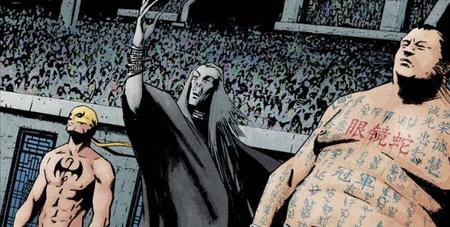
Thank you for this great review,
You’ve definitely rekindled my interest in Iron Fist!
There was however one other excellent martial arts hero from Marvel in the 70s: Master of King Fu, done by the incredible team of Moench and Gulacy. Gulacy styled his artwork after Steranko, and particularly for its day, it was mind-bogglingly good! Paul Gulacy’s entry on Wikipedia is a good starting point.
Cheers,
Anthony
Wow, I’m 180 about a lot of this. I liked the old Iron Fist and Power Man. I always thought that Iron Fist had the coolest background.
Now Ed Brubaker, I’ll give him this. He does have a good knack at expanding the realm so to speak and bring in a stories that have potential. He also has a penchant for promising big and delivering little. He is good for warming things up but he has a big problem of putting out narrative message over story. He can’t keep his extreme politics out of things. That is why the Winter Soldier Captain America movie was so much better than the comic version. Hollywood took his idea but made it better and tossed out the message fiction. Same thing with Iron Fist. I was delighted when he first took over but after he put out his hate filled crap I dropped the line.
I love your posts Derek. You and Oz keep me coming back for more because you are the BEST in my view.
Interesting comments, Ape,
I was fortunate enough as a young kid (born ’65) to read BOTH Power Man and Iron Fist origins as they came out, but fell out of comics by their team up era..
But you’re claiming Brubaker may actually be something of a dystopian comic writer? Admittedly my “youthful” passion for comics was at least partly due in part to the escapist nature, but my adult take on reality has sadly darkened (read a few chapters of “IBM and the Holocaust” by Edwin Black to get a tiny inkling of just how deep that rabbit hole goes :-/). Whatever Brubaker wrote in Winter Soldier (now I’ve got to read that too!), I’m sure it doesn’t hold a candle to any of the transcripts from our Vietnam vets…
All the Best,
Anthony
I’m with you on that Anthony. That era was different when we were kids and were just looking for escapist fun. What I see is that the writing back then was better because the writers grasped the characters better than the writers at Marvel today. There is nothing wrong with dystopian writing, it is usually good story line. I just look at the Hollywood writers of today who seem to have a better grasp of the characters than their counterparts at Marvel. That is why the movies are more successful and comics are dying out. Kids read manga today, not Marvel and DC. A lot of it has to do with trying to pitch story lines at the expense of all the history that went into them.
Take for instance the Green Lantern series. DC and Marvel have wanted for a long time to bring out gay superheroes. Why not? I think the public is ready for them. The trouble is that they chucked the entire history and force fitted a character and it was soundly rejected by their readers. Comic characters remain static for a large part with little incremental changes. Marvel and DC made huge sweeping changes and whenever a character like the Green Lantern comes out of the closet it is the only story they have. They sacrifice message over story and show little respect for the history that took decades to build. Is it any wonder that the gay Green Lantern was erased from the story line? The writers at Marvel and DC can’t get the job done. If you ask me, they have little imagination or writing ability.
Black Panther is another example of taking a great character and ruining him. The series became a caricature of stupid. It isn’t that there is not an interest in non white characters or that a thirst for them isn’t out there, but it is just the inability of the writing teams to do a good job of story telling. Identity politics is what handcuffs Marvel and DC. People like good characters and stories and differences in race, gender, or whatever and they can identify with any character so long as the writing is good. That is my take anyway.
Brubaker is somewhat like Chris Clairmont without the finishing touch. Clairmont grasped the characters. Byrne, was Byrne and he took a darker look to his stories but he also grasped the characters. The story lines they wrote flourished when they touched them. Looking at the circulation ratings, they soared. If you look at the Brubaker years there are some spike here and there but the overall trend is down down down. Captain America is an anemic 33K. That is pathetic.
http://www.comichron.com/monthlycomicssales/2014/2014-03.html
And you are right that it doesn’t hold a candle to the Vietnam vets. I read “IBM and the Holocaust” too. It is a chilling book. I’m glad Hitler did not have an internet or the Jews would have been extinct.
:::::salute::::
All the best to you too Anthony.
Hey Anthony and Ape!
Thanks so much for the kind words. It was a hoot rereading this stuff. On the comments about Brubaker, it may be worth it for me to reread his Cap run where the winter soldier was introduced. My memory may be fading, but I don’t remember that Brubaker is necessarily messagey, but rather that he has a brilliant command of tension and pacing, leaking little story facts that blow up and issue or two later. I listened to a few interviews of him (and a few about him) and he comes from a noir aesthetic that really fits either espionage (Cap’s Silver Age Cold War context) or kung fu (Iron Fist’s context) very well. That said, he’s done brilliant work as well with other properties. The other tricky thing for me is the writing partnership, because Brubaker and Fraction wrote some of these together and then Fraction stayed on a little longer sans Brubaker. But in the heat of creation, how do you separate out who did what. Actually, that’s may emerge as a them in my next post. I want to read Lee/Ditko Dr. Strange to my son and then blog about that. There will be a lot of ambiguity about who created what. Derek
Hi Derek,
Yes! I think a few years back I came across a Brubaker/Fraction independent series that was very noir and hardboiled… as I recall there was a column in every issue titled something like: The Name of the Game is Pulp…” FASCINATING pieces on the history of Pulp heroes and their huge influence on comics 🙂
A few years ago I had the fortune to read the biography “Kirby, King of Comics,” which did an excellent job (I thought) of illuminating the contentions Stan Lee often seems to find himself in with his staff, over “who” actually “created” what.
That aside, it was filled with incredible tidbits: Is anyone a fan of Kiby’s cover of Captain America #1, where Cap is giving the “socko” to Hitler? Well, that issue released in APRIL ’41, eight full months before Pearl Harbor, and Jack “Kirby” Kurtzberg (a Jew) received multiple death threats from German Americans, ga-ga for their horrifying “Fatherland” while it was still fashionable :-/
The early Doctor Strange were amazing, as was one of the reboots from the 2000s, I think… Can’t WAIT for the movie with Cumberbatch!!!
PS: And do check out the Gulacy Master of Kung Fu run when you get a chance… amazing stuff 🙂
Thanks Again Derek!
I love Gulacy’s art, and agree with the Steranko influence. I may have tried to get into Shang-Chi, but it may have been a mid-series thing and so I might have to go back to #1 and go from there. I imagine that the continuity is complex, because it ran over a hundred issues in comics, and was simultaneously in many B&W magazine-sized monthlies as well. “The Comic Book Heroes From the Silver Age to the Present” by Jacobs and Jones is excellent and devoted a short chapter to “The Master of Kung Fu,” so your recommendation is well-supported!
A lot of recent experimental stuff like this is the result of – 1. No more comics code – 2. Adult writers going to stuff they liked as kids. That was what kicked off the modern era in the 80s and what made the Brits, Moore, Gaiman, etc. so popular, that they could go to areas none save the underground dared. Lindsner did a good job on “Killraven” a few years back.
I’ve liked these recent Iron Fist ones – they did neat re-explorations of Power Man also – including Richard Corben art. The art was both better and more experimental.
They should bring back Shang Chi and the “Master of Kung Fu” storyline… but, whoop, CopyWRONG issues with the Rohmer estate over a character that should be Public Domain clearly… Then again, maybe it’d be a pointless ressurection of a charcater deserving rest, like DC did to “I…Vampire”.